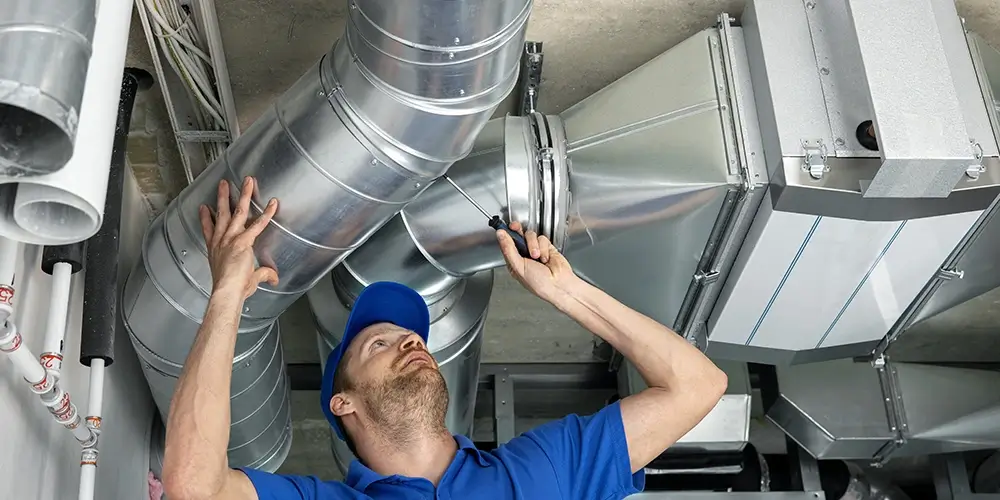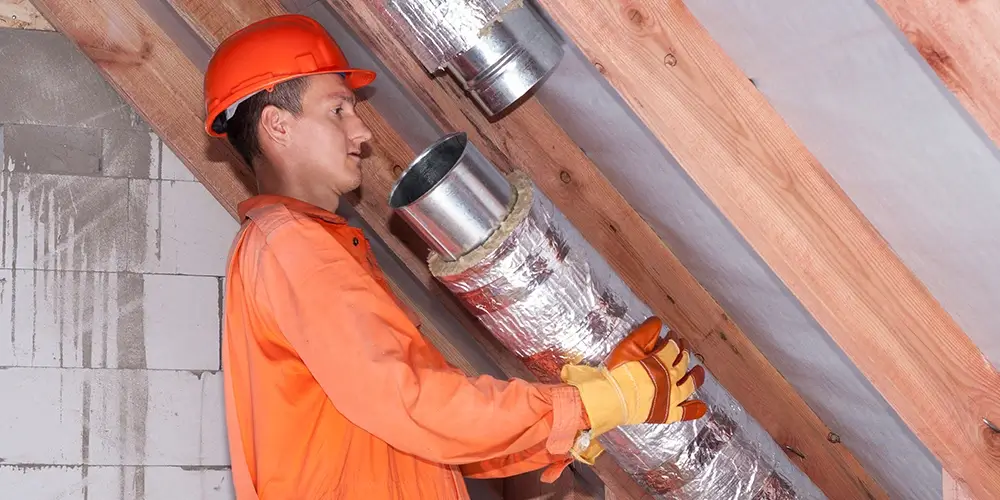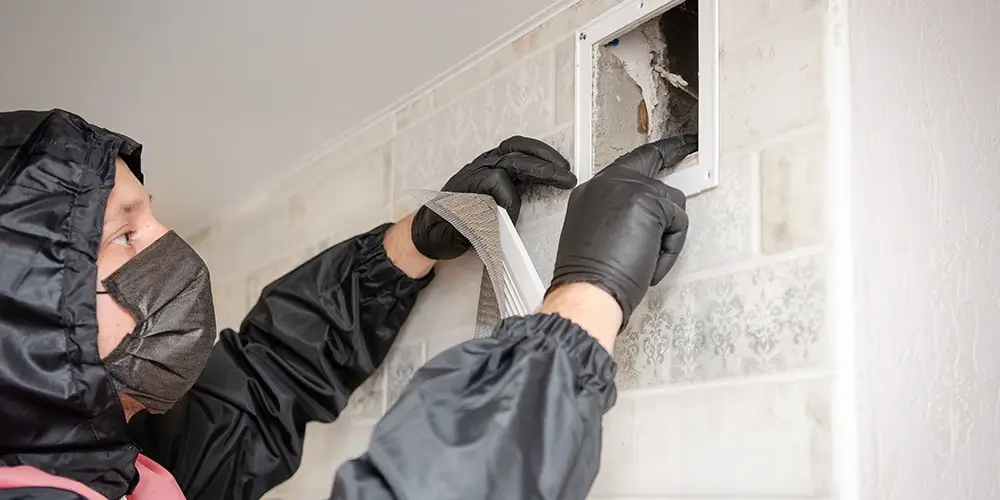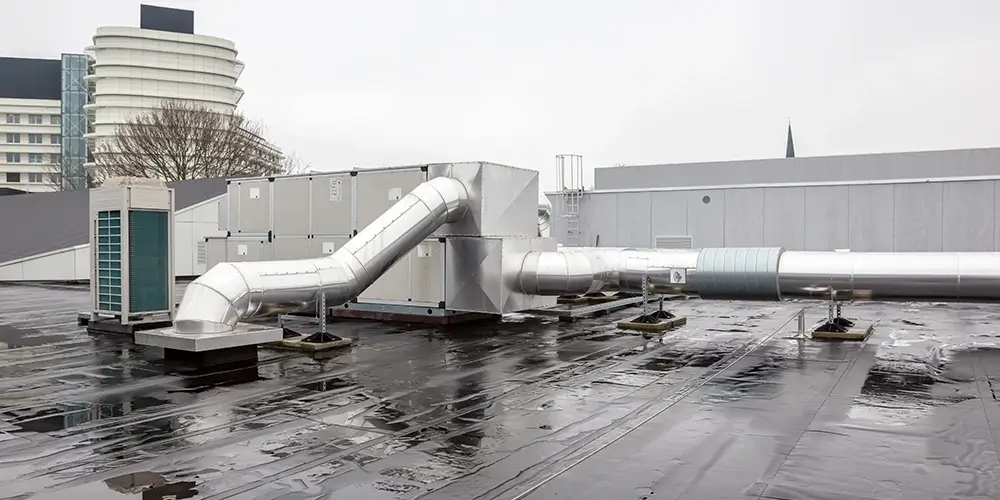Home & Commercial Air Duct Repair & Installation

Your HVAC* System Is Only as Good as the Air Ducts
You’ve spent (fill in the blank) thousands of dollars on a new, energy-efficient air conditioner with a heat pump, air filtration system, smart thermostat, and yadda yadda yadda.
Well done. Your family will breathe easier, your energy bills will plummet like a bad tech stock, and you’ll be sitting in comfort all summer long unless you neglected — and of course, you didn’t — the air ducts.
But you could have if your AC installers didn’t do ductwork (and not all do), if you decided to save a few bucks, or if your ductwork is still in pristine condition.
We’re guessing that your ductwork is at least as old as the old air conditioner or furnace you just replaced. It’s not in pristine condition. And that’s a problem.
*HVAC stands for “heating, air conditioning, and ventilation.”

Bad Ductwork Is Like Bad Plumbing
You wouldn’t run your drinking water through rusty and corroded pipes. The effects would be obvious — brownish, distasteful water with a foul smell.
Yet you do something similar when you pump the air from an HVAC system through old ducts, especially if they haven’t been cleaned in a while.
You may blame your headaches, sniffles, and fatigue on seasonal allergies when the crud from ducts is bringing you down.
- Pollen, dust, and mold collect in the nooks and crannies of your ducts. It only takes a good stiff breeze to blow them free.
- Insects and even rodents may take up residence in the ducts. They have to relieve themselves somewhere.
- If the ducts are metal, they may be rusting away, releasing particles into the air stream.
- Then there’s the possibility of asbestos. If your home was built before 1978, it’s a real possibility. Asbestos fibers can cause lung cancer and other diseases when inhaled.
- The EPA recommends that you have your ductwork inspected and cleaned by a professional every three to five years — more often if you have pets or someone in the house who suffers from allergies or asthma.
- A good inspection will reveal holes, leaks, blockages, and any other problems to fix.
- Cleaning will remove accumulated dust, pollen, pet dander, mold spores, bacteria, etc.
- A certified professional can remove asbestos.
How West Coast Chief Can Help
As part of your scheduled HVAC maintenance or repair, we’ll inspect your ductwork and let you know if it needs work.
- We can fix leaky or damaged air ducts.
- We’ll install new air ducts where needed to improve the efficiency of your HVAC system.
- We don’t clean air ducts — that requires special equipment that we don’t carry — but we’ll point you in the right direction.

All Ductwork Needs Maintenance & Repair
Most ductwork has a life of 20 to 25 years. And even after 15 years, you may have to replace deteriorating parts.
What happens if you don’t maintain the air ducts in your home or business?
- Over time, all ductwork develops leaks. These thermal leaks become a significant source of energy loss in your HVAC system, forcing your air conditioner or furnace to work that much harder, shortening appliance life, and reducing your comfort level.
- Ductwork degrades or becomes obsolete. New materials are far more efficient insulators than materials used 20 or 30 years ago.
- Air ducts get littered with debris like dust, pollen, and even insect feces. And while professional air duct cleaning can mitigate this nasty buildup, it can’t remove everything. It’s just one more reason why, when you replace your aging air conditioner or furnace, you should consider upgrading your ductwork as well.
Air Duct Sealing, Repair & Installation
Leaky or damaged air ducts can be a significant source of energy loss, driving up energy bills, reducing the efficiency of your HVAC system, and forcing your air conditioner and furnace to work extra hard.
Call us to inspect your ductwork.
- There may be leaks throughout your ductwork, which we can seal if the ducts are still in good condition.
- Very old air ducts could be past the point of repair or cleaning. They should be replaced.
- We can design new and improved ductwork for you, install it faster than you thought possible, and have your HVAC system running so efficiently that you’ll wonder why you didn’t call us sooner.

Flexible Air Ducts
Flexible ducts are formed of steel helices covered with a durable plasticized material. They’re popular for several reasons.
- Compared to rigid duct materials like aluminum, fiberglass, and fiberboard, they’re easy to work with.
- They’re relatively cheap to install.
- They can be installed much faster than other types of ductwork.
- They’re mold and mildew-resistant.
- They’re easy to clean since particles don’t stick to them as much as with fiberglass and fiberboard.
- They’re well insulated, and they come in various materials, including hypoallergenic material.
Because they can be punctured, kinked, or easily damaged, flexible ducts demand careful installation away from high traffic or exposed areas.
As with any air ducts, we seal them to prevent leaks and design the entire ductwork system to promote optimal airflow to all parts of a building.
Flexible air ducts should be professionally vacuumed every 3 to 5 years to keep them clear of debris and completely replaced every 20 to 25 years. They degrade over time and reach a point where no amount of cleaning helps. New ducts are the only way to go.
Rigid Metal Air Ducts
Rigid ductwork comes in different shapes and sizes and can be made of various materials, including galvanized steel, aluminum, fiberglass, and fiberboard.
Of these materials, we prefer galvanized steel and aluminum, which are durable and, because they’re non-porous, resistant to mold, mildew, and dirt buildup.
Unlike flexible ductwork, rigid metal ductwork can’t be punctured (at least not easily), but it can be dented, damaged, or distorted, hampering airflow.
- Metal ductwork is best for exposed areas like rooftops or for commercial installations.
- It’s the most durable ductwork, bar none, but it can’t be installed in cramped or tight spaces.
- Fitted joints must be carefully sealed. Poorly sealed metal ducts can be a significant source of air leaks.
- Ducts can be rectangular or cylindrical, insulated or non-insulated. We’ll help you choose the type that’s best for your installation.
As with flexible ducts, metal ducts should be vacuumed out every 3 to 5 years and inspected for debris and leaks.
Commercial Air Ducts
Commercial air ducts see a lot of wear and tear. They’re used more often, larger in size, and have to deal with harsher conditions, like high temperatures, humidity, and more airborne particulates.
We recommend professional cleaning and inspection at least once a year for commercial air ducts.
We also recommend making commercial air ducts of materials that can stand up to the rigors of constant use, like galvanized steel or aluminum.
For new construction or major renovations, we can design and install a new commercial air duct system that will meet your needs now and well into the future.
Call us today for a free consultation.